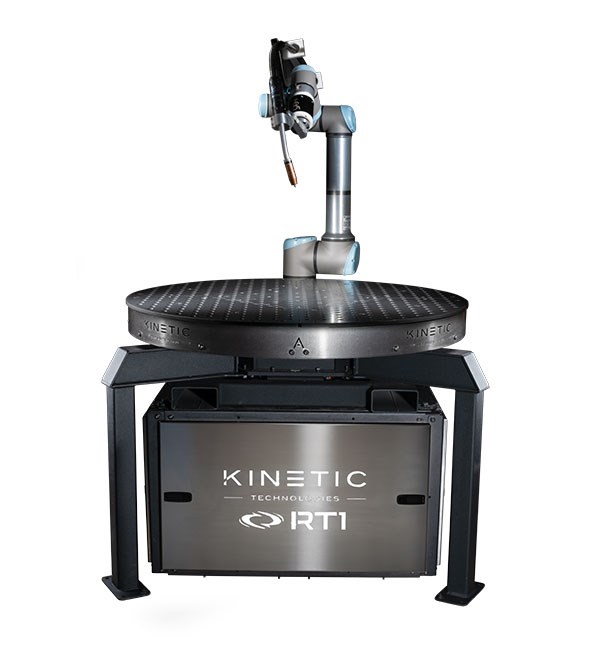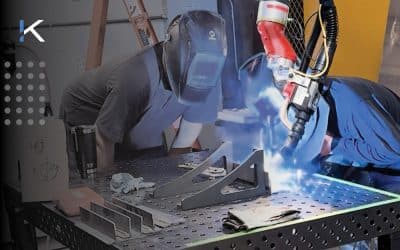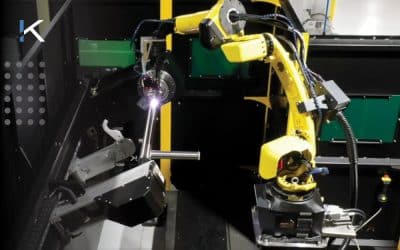In 2021 we knew we wanted to start a company. The genesis of Kinetic Technologies was simply this: manufacture simple parts and start generating revenue. From there, we could add design and complexity and grow and pivot as needed. We quickly learned our new startup couldn’t compete with the prices of the larger volume manufacturers. How would we make our way? The answer became clear: through automation. Our founder’s experience in the automation space was the jumping off point and we dove in head first.
Keep reading to learn how we conceived, designed, developed, patented and built an industrial-strength, robot-controlled rotary welding table: the RT1.
Developing a Maximum-Efficiency Solution for Robotic Welders
Mark Barglof, our president here at Kinetic Technologies, realized that almost every automation cell had some level of customization. What if we created products focused on enhancing and simplifying robotics integration for busy shops?
Universal Robots connected our team to Hirebotics, a welding automation company seeking to increase the productivity of their powerful Cobot Welder, a popular welding robot. Hirebotics customers had requested a “lazy Susan”-style rotating table that would allow welders to weld on both sides of the part. With the guidance of Hirebotics, we set out to design and build our prototype.
Making the RT1
Once we knew exactly what Hirebotics customers needed and wanted, the next step was figuring out how to make it.
We faced two major challenges:
Challenge #1: Create a zero-backlash, high-precision positioner capable of meeting tight tolerance requirements
Our initial market research surfaced numerous automation companies that were producing the style of product Hirebotics wanted. But these fixtures and positioners comprised lower-quality materials that lacked the strength and durability necessary for the kinds of parts Hirebotics customers were making. OEMs in agriculture and construction, for example, needed more than the lightweight, extruded aluminum fixtures that were currently on the market.
To satisfy the critical needs of Hirebotics manufacturing customers, Kinetic Technologies set out to make a positioner that would:
- Maintain a 0.005” datum position from one side of the table to the other
- Achieve flatness within 0.005” across the table’s entire 48” surface
At the outset, we’d planned to use another company’s welding tabletop. We were disappointed to discover that not a single welding table on the market had the flatness necessary to meet our requirements. To prevent increasing a part’s stacked tolerances, Kinetic’s fixture welding table had to be more precise than the robotic welder itself.
As the finishing touch, we also wanted to give manufacturers the ability to program a part on one table and copy that program to other tables. For shops with more than one Cobot Welder, this capability would significantly decrease lead times by eliminating the need for repetitious programming.
We selected Nabtesco as our gearbox provider. They provided us with a gearbox that not only met the demanding requirements we levied on the product, but they exceeded it. Nabtesco has extensive experience supplying gearboxes for rugged manufacturing environments as well as the robotic industry.
Challenge #2: Design and build the rotating fixture welding table within four months
Hirebotics made it clear that they wanted the table ready for demonstration in time for the upcoming FABTECH show.
A four-month turnaround may seem intense, but here at Kinetic Technologies, we’re used to tight deadlines. In fact, our in-house product development process is structured to move through design and iteration phases quickly, frequently getting customers from concept to production in only three months!
Prior to the deadline, Kinetic would:
- Built a working prototype
- Perform a one-million-cycle repeatability test
- File two patents
Get to Know the RT1, Inside and Out
Kinetic designed the RT1 with unique features that other similarly sized welding tables didn’t include:
- First, the high precision rotary aspect of the table extends the robot’s reach and allows for precise weldments on all sides of the part. The RT1 also allows for collaborative part loading and unloading, increasing the arc-on time.
- Next, we added fork pockets, enabling shops to easily relocate the table anywhere in their facility using a forklift. This feature proved unexpectedly challenging to implement, but we knew it was an important addition for small-to-medium manufacturers needing the flexibility to move and repurpose the cell on demand.
- Finally, we made the RT1’s table to allow users to swap out fixtures quickly and easily. Kinetic works with individual customers to design custom fixtures for their shop’s RT1 so they can fully benefit from the automation while meeting their production goals.
For mid-size manufacturers who can’t find enough qualified welders to meet their productivity goals, the RT1 is a dream machine. While fixed welding tables aren’t flexible enough for many shops’ needs, the RT1’s rotation ability enables increased productivity while dramatically simplifying the cobot welding experience.
Your Welding Robot + Our RT1 = Ultimate Automation Productivity
You can find the RT1 in shops using Hirebotics welders, but other possibilities exist. Kinetic is a U/R+ Partner and has a certified U/R CAP application for direct control using a U/R cobot. We will continue to partner with other automation companies who want to use our patent-pending RT1 high-precision positioning systems for their own automation cells!
If you’re ready to learn more about the RT1, head over to the product page on our website.
Questions? Comments? Contact us!

Mark Barglof is the President and owner of Kinetic Technologies, LLC, a robotic welding integration shop just north of Algona, IA. After serving in the military and earning the U.S. Army Ranger Tab, Mark shifted career paths and dove into the world of manufacturing. His vision is to build a full-service engineering and robotics company that can bring to bear all the advanced engineering tools to support their clients and make their concepts come to life quickly. They are intently focused on robotic welding integrations, robotic welding positioners and fixtures, and custom machine building.




